

Alphabet books offer a vivid insight into the history of literacy and culture, as well as concepts of childhood. The Children's Book Collection at UCLA contains a rich array of these materials, some well-worn and much-used, some still bright and fresh. Each is a gem of print production and graphical imagery from another time and place. Though the history of alphabet books continues to the present, this exhibit focuses on the works in our collections published between 1700 and 1900, including horn books, primers, works of didacticism and seriousness, whimsy and play.
2. A Jumble ABC
3. A Little Pretty Pocket-Book
4. A New Lottery Book of Birds And Beasts
5. A Pretty Play-Thing for Children of All Denominations
8. ABC of Objects for Home And School
10. ABC with Pictures & Verses
12. Alphabet Et Instruction Pour Les Enfans
16. Dolly's ABC Book
17. Flora's ABC
18. Home ABC
22. Hornbook C. 1700
23. Large Letters for the Little Ones
24. Little ABC Book
25. Little People: An Alphabet
26. Martin's Nursery Battledoor
27. Mother Goose ABC
28. My Darling's ABC
29. Orbis Sensualium Pictus Quadrilinguis
30. People of All Nations: A Useful Toy for Girl Or Boy
31. Picture Alphabet
32. Pretty ABC
33. Railway ABC
34. Rusher's Reading Made Most Easy
38. The Alphabet of Old Friends
40. The Amusing Alphabet for Young Children Beginning To Read
42. The Child's Christian Education
45. The Easter Gift
47. The Favorite Alphabet for the Nursery
49. The Franklin Alphabet And Primer
51. The Golden ABC
55. The Moral And Entertaining Alphabet
57. The Old Testament Alphabet
59. The Picture Alphabet for Little Children
62. The Sunday ABC
63. The Union ABC
64. The Young Child's ABC, Or, First Book
65. Tom Thumb's Alphabet: Picture Baby-Books
67. Warne's Alphabet And Word Book: with Coloured Pictures
68. Wood's Royal Nursery Alphabet
Title The Picture Alphabet
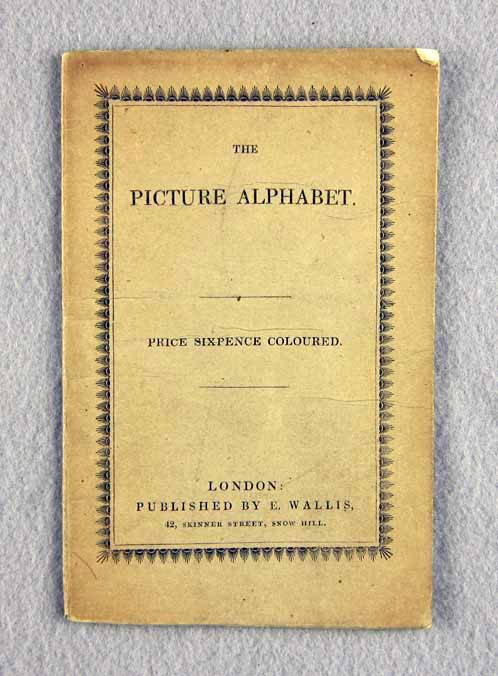
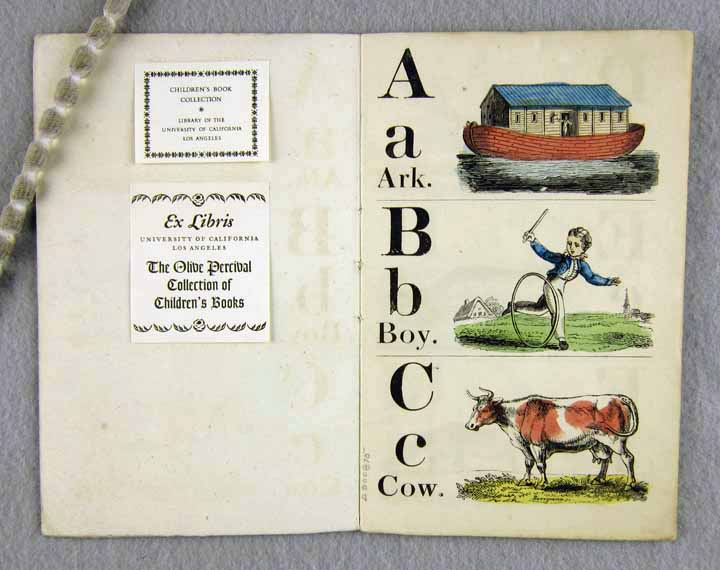
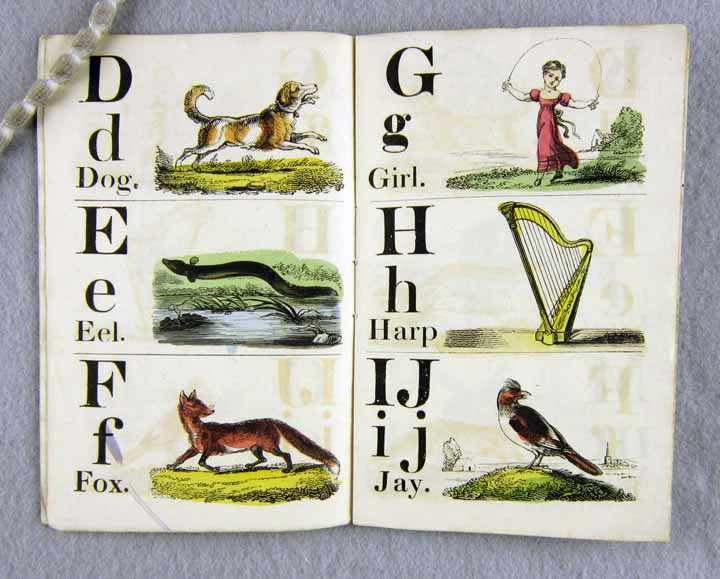
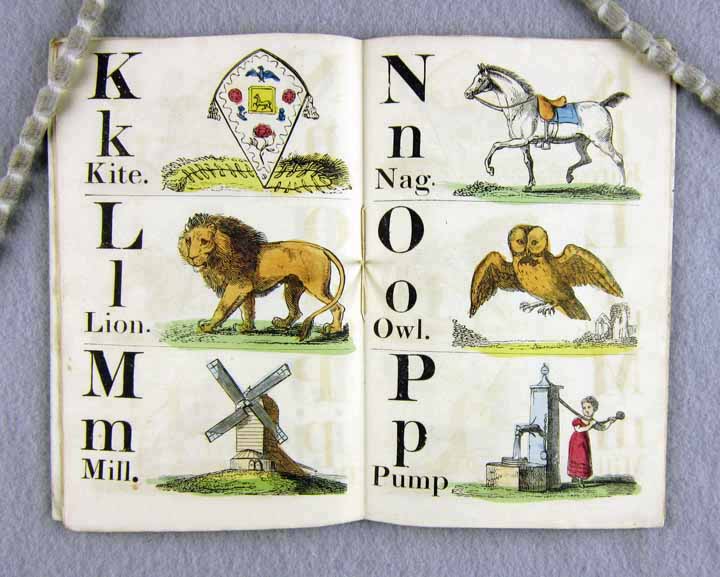
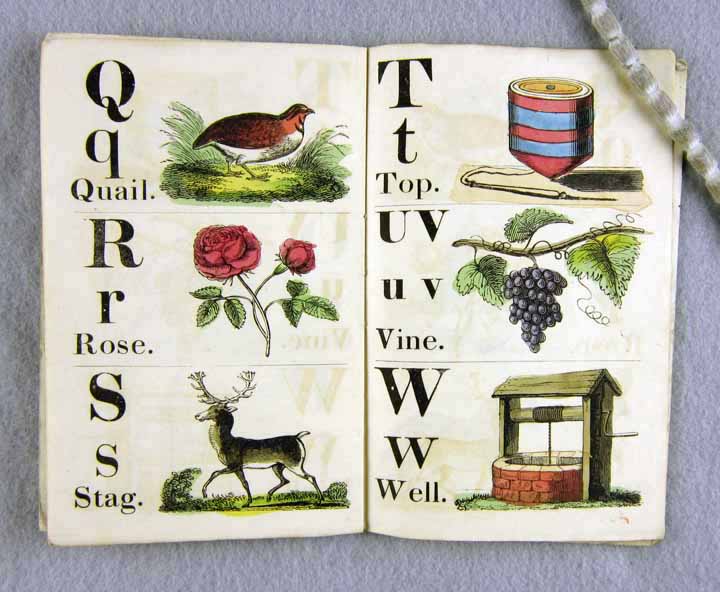
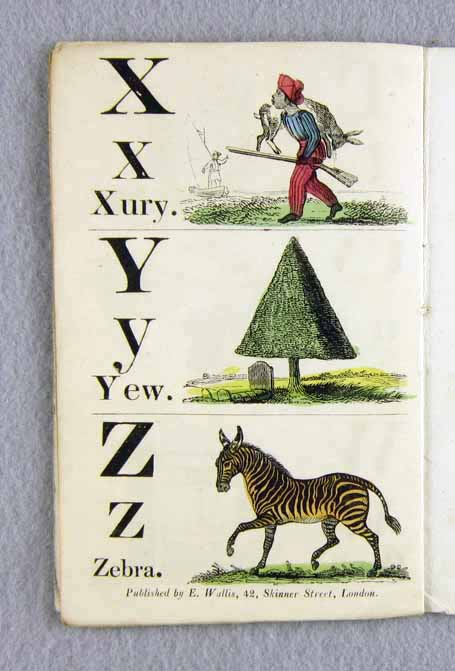
Brief description [8] leaves : col. ill. (woodcuts) ; 16 cm. Cover title. Approximate dates based on publisher's address, established from Brown, P. London publishers and printers c. 1800-1870, p. 212. Woodcut illustrations, hand-colored. Price sixpence coloured--Upper wrapper. Publisher's printed grey stiff wrappers; publisher's advertisement on lower wrapper. Ex libris Olive Percival.
Full description As part of the "First Steps in Reading" series by E. Wallis, The Picture Alphabet is simple in design, but rich in color and imagery. Hand colored with care and precision in a stenciling technique called pochoir, the alphabet is depicted in a typical letter/word presentation: "K/k/Kite." Images are paired directly to the right of the alphabet/word pairing, requiring little effort to associate letters to their representations in the real world. There are no advanced studies in literacy present here, only single words, and all but Q, X, and Z (Quail, Xury, and Zebra) have one syllable pronunciations.
Literacy Dame schools arose throughout the area during this period, which were less like "schools" as we understand them, and more like open living rooms where women taught students on their own accord to read and write, usually using basic alphabetic texts such as New England Primers and this A Picture Alphabet pictured here. Due to the scattered nature of dame schools in both Britain and England, laws were unable to enforce the requirements of readings. Basic literacy was most often taught to children in the home by fathers and mothers, as state-instituted places of schooling weren't yet rigidly and practically situated to handle the onerous task. Regulation was nearly impossible and was to be further developed as we proceed in the 18th century. Dame school methods of learning transformed into more sophisticated, partly centralized, roving methods of education, with pastors teaching at various community centers over an extended period of time. The advent of Summer Schools and Grammar Schools further centralized educational norms, and also increased levels of literacy to younger girls (who were previously only taught basic skills, in deference to boys who were prepared to take on higher education).
Childhood The early 19th century set the stage for the emergence of the child as a solid and distinct stage of human life. The children in this book are more cherubic and painted in filtered lights, connoting innocence. In the wake of Jean-Jacques Rousseau's writing (which emphasized raising the child in a natural state sans oppressive rules and moral teaching), the upbringing of the child becomes more organic and caters to the natural development of their minds, letting the child grow "on their own terms" within nature. Images of children in A Picture Alphabet, consequently, live in a world where the owl, nag, and mill stand in juxtaposition (and similar stature) to their vignettes of play and rural work. Childhood is revered, even touted as the freest stage in one's "adult' life" (for even the adult must keep that child in him). Emerging soon after this focus on natural development and morals, is the Romantic ideal, illustrated in the works of Wordsworth, Blake, and Coleridge, which fought to bring forth the Imagination and the sense that the new "Lord" of creation was the mind's eye. This romantic ideal, coupled with the continued need for moral compasses within children's literature, led to the wider acceptance of imaginative poems and tales of fancy.
Iconography The Picture Alphabet is rich with imagery. The alphabet opens with "A/a/Ark," and closes with "Z/z/Zebra"--an alphabetic range that encompasses both religious imagery and representations of the secular natural world. Images are colorful, opulent in content (G is for grapes, which were luxurious in 19th century England) and represent a certain levity. The "Boy" plays, seemingly carefree with his hula-hoop toy ringing around his ankle, while the "Girl" both jumps a rope in the countryside and pumps water at a larger-than-life well (an interesting inversion, since boys are more often depicted doing laborious work). The "Yew," tall and mighty, shades a gravesite in a churchyard--the yew having a strong association with cemeteries as images of both rebirth and death, reminding us of the relatively short life-span children experienced in the early 19th century. Death was something taught and understood as a reality of life, as life expectancy in this period was only about 40 years. Lastly, stands the "Harp" for "H," reminiscent of the Aoelean harp image often invoked by Romantic poets such as Samuel Taylor Coleridge in the 19th century, seen as a metaphor for the imagination. The harp played music as wind blew in between the delicate strings, much like ideas flow though the mind. And in between these poignant images of imagination, religion, labor, and opulence, stand a plethora of icons from nature: a fox, eel, dog, and stag--all of which represent a world full of life and secular nature. The Picture Alphabet bears the impression of many facets of society: Romantic ideas, religious allusions, and nature viewed objective for both the splendors of its life and the realities of its death.
Production Publishers of the early 19th century flourished with a more efficient distribution network thanks to newspaper routes that were embedded into London's daily lives owing to John Newbury's efforts, serialization of children's literature began to take hold, new forms emerge, and more formal processes are in place for children's book production. The Picture Alphabet is an example of this type of serialized printing, since it was issued as part of a larger series of children's books whose titles include Riddle Book, Nursery Reading, Birds, and Beasts. . Chapbooks, small adventure books, as well as much larger formats of children's books emerged during the late-18th and early-19th centuries. Books, as is seen in The Picture Alphabet, displayed images of exotic animals, foreign cultures, mixed with the ever-familiar biblical references. Traveling from one location to another was becoming faster and easier, and books began to incorporate images, objects, and animals from afar. The lavishly colored Picture Alphabet, costing 6 pence (3d, or pennies), was roughly $1.70 cents according to 2005 conversion rates for the British Pound, and illustrates the extent to which people were willing to pay for the luxury of color. Black and white books of a similar stature and pagination were far less expensive without the costs involved in embellishing the images with such care.
Publisher E. Wallis
Publication place 261 Pearl-street, Snow Hill
Date 1818
UCLA Call Number CBC PE1119.A1 P5302 1818
Repository UCLA Charles E. Young Research Library, Dept. of Special Collections
Dimensions 16 cm
Technologies of production Woodcut (process)
Caption